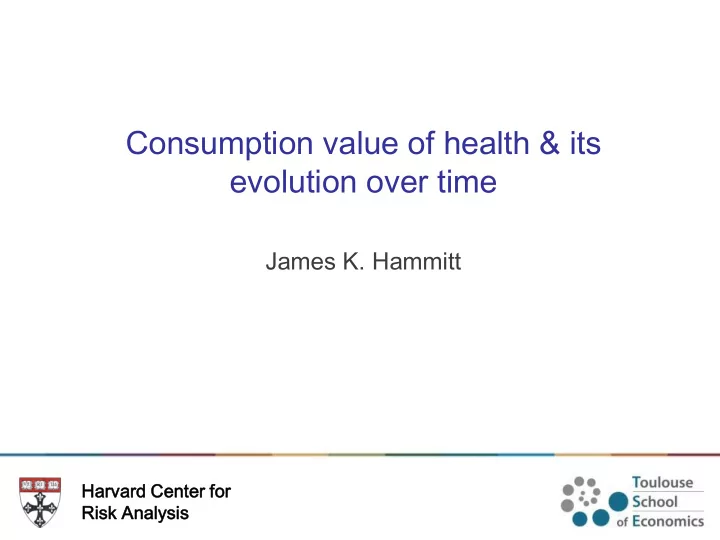

Consumption value of health & its evolution over time James K. Hammitt Harvard ard Center er for Risk Analysi ysis
Outline • Conceptual issues • Evidence (relevant, available) • Reasonable assessment 2
Value per statistical case • Individual’s rate of substitution between own: ― wealth ― probability of avoiding/preventing specified health outcome o within defined time period • Most research on small changes in probability of death ― Value per statistical life (VSL) ― Marginal rate of substitution ― Model can be applied to non-fatal health effects 3
VSL = slope (local) Indifference curve Wealth VSL x 0 Survival probability ( = 1 - risk) 1 4
Standard model of VSL • maximize 𝐹𝑉 = 𝑡𝑣 𝑏 + 1 − 𝑡 𝑣 𝑒 ― s = probability of surviving time period ― u a = utility conditional on surviving period ― u d = utility of leaving wealth as a bequest ― u a , u d are functions of o wealth o future conditions given survival – life expectancy – health – earnings, expenses – other factors that influence wellbeing o future conditions given death – number dependents – preferences for leaving wealth to others 5
Standard model of VSL 𝑒𝑥 𝑣 𝑏 −𝑣 𝑒 ∆𝑣 𝑣𝑢𝑗𝑚𝑗𝑢𝑧 𝑤𝑏𝑚𝑣𝑓 𝑝𝑔 𝑡𝑣𝑠𝑤𝑗𝑤𝑏𝑚 • 𝑊𝑇𝑀 = − 𝑒𝑡 = ′ = 𝐹𝑣 ′ = ′ + 1−𝑡 𝑣 𝑒 𝑡𝑣 𝑏 𝐹 (𝑝𝑞𝑞𝑝𝑠𝑢𝑣𝑜𝑗𝑢𝑧 𝑑𝑝𝑡𝑢 𝑝𝑔 𝑡𝑞𝑓𝑜𝑒𝑗𝑜) • Assume u a > u d survival preferred to death u a ' > u d ' ≥ 0 marginal utility of wealth larger given survival marginal utility of bequest non-negative u a ", u d " ≤ 0 (weak) aversion to financial risk • Conclude 𝜖𝑊𝑇𝑀 𝜖𝑊𝑇𝑀 𝜖𝑥 > 0 𝜖𝑦 ⪋ 0? ― Increase in w: ― Increase in x (health, life expectancy): o Increases numerator o Increases numerator o May increase denominator o Decreases denominator 6
What would constitute relevant evidence for evolution of value of health? • Value of health is ratio of ― Utility gain from better health (numerator) ― Expected opportunity cost of spending (denominator) • Value of health does not change autonomously • May change in response to changes in factors that affect numerator and/or denominator ― To forecast change in value of health, must forecast changes in values of factors that influence it dv v w v x t t t i dt w t x t i i 7
What would constitute relevant evidence for evolution of value of health? • Numerator & denominator depend on multiple factors that may change over time ― Wealth, real income o Increase value of health o Note: utility value of consumption depends on – Available goods & services, which change over time – Risks to wealth & consumption – Risks to health that affect utility of consumption ― Effects of health, life expectancy, other factors? o For VSL, health & life expectancy increase numerator, may increase denominator • Value of avoiding nonfatal health state ― Technology, social support decrease numerator, decrease value? 8
Available evidence: empirical estimates • Revealed preference (compensating wage differentials) ― Cannot estimate wealth dependence directly o wage is dependent variable ― Compare VSL with income & other factors between samples o Meta-analysis, cross sections at different dates • Stated preference ― Estimate effects of income & individual characteristics on WTP within sample ― Compare VSL with income & other factors between samples • Wealth v. other factors ― Within-sample comparisons can isolate effect of wealth ― Between-sample comparisons include effects of other factors • Little research on ― effects of factors other than income (some on age) ― effect of income & other factors on value of nonfatal risk 9
Empirical estimates (mostly US) Referen rence ce Method hod Income ome elasticity ticity Kniesner, Viscusi, & Ziliak Wage differential, quantile regression 1.2 – 2.2 (highest 2010 to lowest quintile) Viscusi 2015 Wage differential, meta-analysis 0.8 – 1.1 Viscusi & Masterman Wage differential, meta-analysis 0.5 (US) 2017 1.1 (international) Corso, Hammitt, & Stated preference, traffic risk 0.4 Graham 2001 Hammitt & Haninger 2010 Stated preference, pesticides 0.1 Cameron & DeShazo Stated preference, multiple 0.7 2003 Costa & Kahn 2004 Wage differential 1940-1980 v. GNI pc 1.5 – 1.7 Hammitt, Liu, & Liu 2017 Wage differential 1982-1997 Taiwan v. 0.6 – 0.9 HH income, risk, workers 10
In preparation • SP study in Chengdu, China, 2005 & 2016 ― VSL increased 20x ($25,000 → $500,000) ― Household income increased 4x ($3,000 → $12,000) • Meta-analysis of VSL estimates in LMICs ― General population, data collected in last 20 years o 34 SP studies (17 countries) o 9 RP studies (8 countries) ― Regress VSL/GNI pc on GNI pc o SP: income elasticity ≈ 0.7 o RP: income elasticity ≈ 0.1 11
Stated preference 12
Revealed preference 13
A reasonable assessment? • Project change in value as (change in wealth) x (response to wealth) ― Project change in wealth/income ― Use a central-value wealth elasticity of about 1 • Conduct sensitivity analysis ― Could changes in factors other than wealth be important? • Be very humble 14
Recommend
More recommend